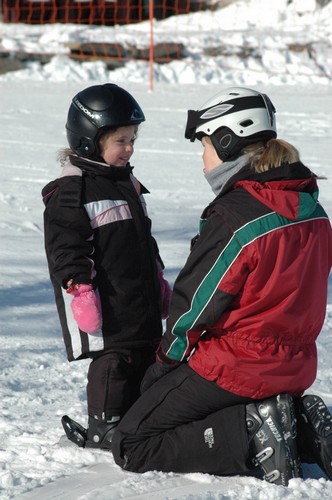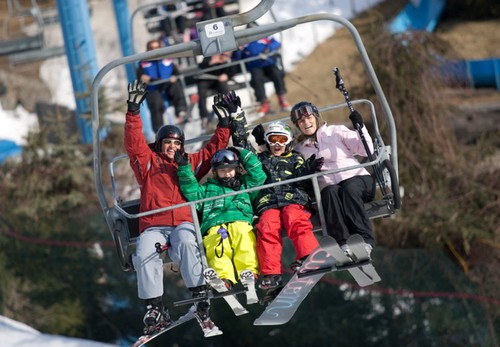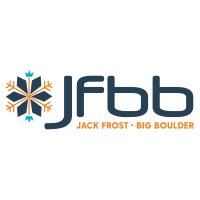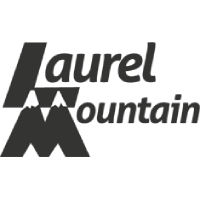Top 10 Questions asked about the "First Day"
1. How safe is skiing?
Statistically, skiing or snowboarding is no more hazardous than bicycling or tennis. It used to be though, in the days of long, stiff wood skis, non-support boots and non-release bindings. Now, with modern equipment such as fiberglass skis, high-support plastic boots and release bindings, skiing is much safer.
2. What will it cost?
Skiing, snowboarding, and tubing is not as expensive as you think. You can ski on a budget and spend a lot of time on the slopes. Whether it's at a local area for a few hours or longer for a ski vacation. Ski equipment can be rented, and as for clothing, you probably already have clothes which could double as a ski outfit. Most Pennsylvania areas do however have great "starter" packages to help you learn and save money. Check out our Deals section for more details.
3. How long will it take to be able to ski or ride?
Just in your first day, you'll learn how to turn, slow down, stop and ride the lifts. Generally, if you are trying skiing for the first time, you should be able to do quite a bit on your first day. Snowboarding is a bit more difficult the first time. However, the learning curve is much easier after just a few tries. With today's modern teaching methods, you can be past the beginner stage after four or five lessons, which means you can ski 50% of the ski trails in the United States and possibly 100% at many of the Pennsylvania Ski Areas.
4. Do I have to be in shape?
You don't have to be an athlete to ski. Today, modern equipment does most of the work for you. If you do some exercises before your first ski experience, you will enjoy it more. First of all, you'll learn faster, because you won't tire so easily during the learning process. You're going to fall down some while learning so you'll bounce back better if you're in shape. Walking briskly, jogging, jumping rope, or stretching are great ways to prepare for a day on the slopes.
5. What kind of Facilities should I expect?
Every ski area, whether a day (no lodging) or destination (lodging) area, has the same basic facilities:
* A mountain with ski lifts to transport skiers to the top.
* Trails of varying difficulty to ski back to the bottom.
* A base lodge with food service, restrooms, ticket window, ski school, and Patrol.
* Parking lot.
* At the mountain or nearby are ski and rental shops, and, if a resort area, lodging, restaurants, bars, shops and services.
6. How should I dress for different temperatures? How can I find out the conditions before I go?
Every ski resort publishes a "conditions" report or a "ski report." Usually it's done daily and gives you a summary of the temperatures, trails open, lifts running, weather conditions, and more.
Here's some clothing tips to keep in mind for different temperatures:
40° AND ABOVE - TORSO: turtleneck or shirt or T-shirt, plus wind shirt or light jacket. LEGS: pants only. HEAD/FACE: light hat or none. HANDS: light gloves or liners. FEET: light socks. Put lift ticket on a garment that will not be removed.
28° TO 40° - TORSO: turtleneck or shirt plus medium parka or jacket. LEGS: long johns and pants; or pants and warm-ups; or bib ski pants. HEAD/FACE: light or medium hat. HANDS: medium gloves or wool mittens. FEET: light socks.
15° TO 28° - TORSO: turtleneck, light sweater, and medium to heavy parka or jacket. LEGS: thermal long johns and heavy pants; or medium pants and warm-ups; or long johns and bib ski pants. HEAD/FACE: medium to heavy hat. HANDS: heavy gloves or wool mittens with liners. FEET: medium socks.
5° TO 15° - TORSO: turtleneck, shirt, medium sweater or vest, plus heavy parka or jacket. LEGS: thermal long johns, pants and warm-ups; or thermal long johns and bib ski pants. HEAD/FACE: heavy tight-knit hat that covers ears and forehead. HANDS: heavy gloves or heavy wool mittens with liners. FEET: wool socks.
5° AND BELOW - TORSO: thermal undershirt, turtleneck, shirt, heavy sweater or vest, plus heavy parka or jacket. LEGS: heavy thermal long johns, heavy pants and warm-ups; or heavy thermal long johns and bib ski pants. HEAD/FACE: salve on face. Face mask or scarf and neck gaitor over mouth and nose. Goggles to cover eyes. Heavy tight-knit hat that covers ears and forehead. HANDS: heavy gloves with liners or heavy wool mittens with liners and windproof shell. FEET: wool socks. Keep boots loose to aid circulation. If windy, add another layer to torso. No exposed flesh on head. Add hood to parka if available.
7. Should I take a Lesson?
Did someone teach you how to drive? Of course, it's the easiest way to learn the "rules of the road." Most ski areas have a beginner's area with a wide, gentle slope and a beginner's lift. At the bottom of the slope, your Snow Pro will introduce himself and familiarize you with your equipment. During the first lesson you will learn how to walk, maneuver and control your skis by turning, slowing down and stopping. When you are ready, the Snow Pro will show you how to ride the beginner's lift and will ski down the beginner's slope with you. After your lesson you can continue practicing what you've already learned.
After you have mastered the fundamental skills of skiing (turning, slowing down, stopping and riding a lift), you'll be able to explore other trails while you practice what you've learned. Keep to the "Easier"' trails which are marked with green circles. There will be signs so marked at the beginning of the trail.
8. Is there a Glossary of ski, snow, and weather terms I should know?
Alpine skiing: Downhill skiing.
Apres-ski: The night life following a day on the slopes.
Base: The bottom of the mountain where the lodge is situated, or the average depth of snow on a mountain.
Base snow: That cumulative depth of snow (old snow or snow pack) that resides on the ground excluding new surface cover. It usually is measured following snowfalls and thaws at the base and near the summit. Base depths and new snow measurements are usually given in a range, with the first figure representing average depths or accumulation at the base and the second figure indicating measurements at the summit.
Bindings hold your boots to the skis and are designed to release when you need them to during a fall. Many bindings also have vibration-reducing features that allow you to ski more smoothly. Your ability and weight will determine the binding you choose.
Bunny slope: The most gently sloping hill on the mountain, usually used to teach beginners.
Carving: Making turns on the ski or snowboard with the edges cutting into the hill.
Catching an edge: Not so good. A fall or near-fall where the edge of your ski or snowboard digs into the snow, usually catching an indentation made by another skier.
Catching some air: Going fast enough to have both skis or the snowboard off the snow after riding over a small hill or mogul.
Corn snow: Loose ice-like granules the size of corn kernels which are usually the product of the above/below freezing cycle of temperatures typical of Spring days.
Cruising: Making a long run at an easy speed.
"DIN": The retention setting on bindings are measured in "DIN," which stands for Deutsche Industrie Norm. In general, the higher your weight and skiing ability, the higher the DIN setting. Have a ski shop technician determine and set your DIN for you.
Fall line: The straightest and steepest line down any slope. One you'll likely take if you fall.
Freezing rain: Rain which does not freeze until it makes contact with the ground. Ground temperatures are sufficiently cold enough to allow the falling rain to freeze on contact.
Frostbite: Extremely cold temperatures reduce the blood flow to body extremities and surface tissue resulting in a lack of feeling (numbness) and epidermal tissues turning white.
Frozen granular: A hard surface of old snow formed by granules freezing together after warm temperatures or by the granules freezing together after a rain. A surface that is less hard than ice and which will support a ski pole stuck into it.
Gaper: A skier who pauses to take in the scenery. They get their name from the gap between their hat and goggles.
Granular surface: Snow that has been groomed and is not fresh powder. The surface looks like millions of little, snow pellets.
Green circles, blue squares and black diamonds: The markings used to indicate the difficulty of a mountain's slopes. Greens are easiest, blues moderate or intermediate and blacks advanced. A double black diamond indicates the toughest run. Be aware that designations are for that particular mountain; a blue run at Aspen is not necessary as easy or as tough as a blue run at Mad River. They also differ on each mountain.
Hypothermia: A serious, potentially fatal condition that occurs when a person has been cold for so long that he has lost the ability to rewarm himself. This happens when all the "stored energy" is used up with nothing left to keep body temperature at a safe level. A person becomes unable to take care of himself properly and frequently does not even know that he is in trouble. Symptoms: violent shivering, loss of coordination, speech garbled, general appearance of being "out of it."
Ice: A hard, glazed surface usually created by freezing rain or large quantities of rain or old surface snow melting and quickly refreezing again. Also a very wet surface skied into a smooth surface while above-freezing temperatures are existent and then rapidly dropping temperatures occur. When broken it breaks into chunks rather than granules.
Loose granular: Loose granules formed after powder snow thaws, refreezes and crystallizes; or, an accumulation of sleet. Also may be produced by machine grooming of frozen granular or icy surfaces.
Machine snow: Very fine crystals of snow produced when atomized water, which is sprayed into the air by a snowmaking 'gun', freezes and falls to the ground as snow. Depending on temperature, humidity, type of snowmaking system and type of snow desired, machine snow can be either dry or wet.
Mashed potatoes: Wet, heavy snow.
Measure up-Skis are measured in centimeters (cm). Your ski length will depend on your ability, height and weight. A shop employee will help you decide on the appropriate length.
Milk run: The first run of the day.
Moguls: The mounding of snow into multiple bumps all over the trails by continuous rhythmic turns made in the same spot over a period of time.
New Snow: The new fallen snow which has not yet settled into the existing snow base. It is measured at the base and near the summit.
Off-trails: In most cases, probably where you shouldn't be.
Packed powder: Loose powder snow compacted by skier traffic or mechanical apparatus to a state which leaves little air space between particles. Also may be produced by dry machine-made snow.
Parabolic (also called shaped) skis: Also called hourglass skis or shaped skis. Allowing strong intermediate skiers to ski like experts, and beginners to make those pretty turns sooner. They promise speed and control, responding to the slightest pressure.
Poles are used to help you with your balance and rhythm while skiing. Poles can be made from fiberglass, aluminum, graphite or some combination of these materials. Poles are measured in inches.
Powder: New snow generally of a dry and fluffy consistency. (Will not make a snowball easily.)
Schussing: Skiing straight downhill, often in a full tuck position. Not permitted.
Ski boots come in traditional American sizes and also "mondo point," which is simply the length of the boot in centimeters.
- When trying on boots, wear one pair of medium-weight or light-weight socks.
- The fit should be snug and your heel should remain in place when you flex your knee and ankle forward into the boot.
- Your toes should barely touch the inside of the boot and then, when you bend your knee forward, your toes should slide back slightly.
- Make sure there aren't any pressure points or spots that pinch your feet and legs.
- Remember, the boots will stiffen in the cold.
Sleet: Solid, crystallized pellets with angular or round surfaces (as opposed to soft flakes of snow) which often fall when warm and cold air collide.
Snowplow: Often the first technique a beginner learns. The front tips of the skies are almost touching as the back tips are bowed outward, creating friction and helping with balance and control. Even advanced skiers use the technique at the beginning of runs while they put on gloves or adjust goggles.
Wet granular: Loose or frozen granular snow which has become wet and soft from a thaw or from rainfall. Provides a delightful skiing surface.
Wet snow: Powder snow that is wet when it falls (you can easily make a snowball) or dry powder or packed powder that becomes wet because the temperature rises above freezing or is dampened by rain.
White-out: A sudden gust of wind kicking up the snow's surface. A gust so dense as to obscure vision.
Wind Chill: The cooling power of the wind and temperature on exposed flesh expressed as an equivalent of temperature in still air.
Windpack: Dry powder snow driven and packed hard by the wind so that it becomes hard enough to partially support a skier.
Yard sale: A wipeout fall in which skis, poles, hat, etc. end up strewn along the mountainside.
9. What are the basics I need to know before using a Lift? It is recommended that you take a lesson or get help from a Ski Resort associate before attempting to ride one for the first time. The majority of ski lifts in this country are chairlifts (1,2,3 or 4 passenger) with the remainder comprising of gondolas, trams and surface lifts (T-bars, Pomalifts, J-bars, and rope tows).
It is recommended that you take a lesson or get help from a Ski Resort associate before attempting to ride one for the first time. The majority of ski lifts in this country are chairlifts (1,2,3 or 4 passenger) with the remainder comprising of gondolas, trams and surface lifts (T-bars, Pomalifts, J-bars, and rope tows).
Here are some basic rules for riding all ski lifts:
1. Obey all loading and other instructions on lifts.
2. Do not use a lift until you are familiar with its operation. Read the instruction signs. Watch and learn. Ask if you are in doubt.
3. Slow down before approaching the entrance to a lift.
4. Load and unload only at designated areas.
5. Be polite and courteous at the loading area. Wait your turn, try to keep off other people's skis, and double or triple up for chairlifts or T-bars.
6. Have your lift ticket or season pass visible to the ticket checker or lift operator so you do not hold up the line.
7. On chairlifts, keep your ski tips or snowboard up as you leave the loading area and upon approaching the unloading ramp.
8. If you fall while getting on or off the lift, keep your head down and crawl quickly out of the way.
9. Do not bounce, ski out of the track, or otherwise abuse lift equipment. You may cause injury to yourself or others.
10. Make sure no loose clothing or long hair is caught in lift when unloading.
11. Move quickly away from unload areas to make room for the next skiers.
12. If a lift stops, do not attempt to get off. Remember, if there is a mechanical problem, area personnel will provide assistance.
13. Take special precautions to help small children load and unload. Do not allow them to ride a lift alone until they can do so properly. You are responsible for your children and their actions.
10. What suggestions can you give me to get on or off a lift?
CHAIRLIFTS
Loading Instructions
1. Straps off wrists.
2. Hold poles in inside hand.
3. Step quickly into position.
4. Look over outside shoulder, grasp bar as chair approaches and sit down gently. ON TRIPLE AND QUAD CHAIRS: middle skiers should grasp back of chair as it approaches. Sit down gently.
5. Do not bounce or swing.
Unloading Instructions
1. Stand up at designated point and ski down the incline.
2. Move quickly away from moving chair and keep unloading area clear.
ROPE-TOWS
Loading Instructions
1. Remove straps from wrists.
2. Hold poles in outside hand.
3. Step quickly into position.
4. Look over inside shoulder, grasp tow and hold on.
5. Do not sit down or lean back!
Riding Instructions
1. Flex knees.
2. Keep skis in the track.
3. Do not sit down or lean back!
4. Get off only at designated area.
Unloading Instructions
1. Drop the rope and ski away from the unloading area.




















